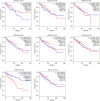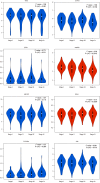Potential mechanism of Camellia luteoflora against colon adenocarcinoma: An integration of network pharmacology and molecular docking
- PMID: 40547172
- PMCID: PMC12179932
- DOI: 10.4251/wjgo.v17.i6.105782
Potential mechanism of Camellia luteoflora against colon adenocarcinoma: An integration of network pharmacology and molecular docking
Abstract
Background: Camellia luteoflora is a unique variety of Camellia in China which is only distributes in Chishui City, Guizhou Province and Luzhou City, Sichuan Province. Its dried leaves are used by local residents as tea to drink with light yellow and special aroma for health care. It has high potential economic medicinal value. Colon adenocarcinoma (COAD) is the third most frequent malignancy and its incidence and mortality is increasing. However, the current common treatments for COAD bring great side effects. In recent years, natural products and their various derivatives have shown significant potential to supplement conventional therapies and to reduce associated toxicity while improving efficacy. In order to overcome the limitations of traditional treatment methods, the global demand and development of natural anti-COAD drugs were increasingly hindered.
Aim: To investigate the potential targets and mechanisms of Camellia luteoflora anti-COAD.
Methods: Nuclear magnetic resonance and mass spectrometry was used to identified the compounds of Camellia luteoflora. Network pharmacology analysis and survival analysis was used in this study to investigate the anti-COAD effect and mechanism of Camellia luteoflora.
Results: Firstly, a total of 13 compounds were identified. Secondly, 10 active ingredients for 204 potential targets were screened and protein-protein interaction analysis showed that TP53, STAT3, ESR1, MAPK8, AKR1C3, RELA, CYP19A1, CYP1A1, JUN and CYP17A1 were hub targets. GO and KEGG enrichment analyses revealed that Camellia luteoflora exerted anti-COAD effect through multiple functions and pathways. Then, the analysis of survival and stage indicated that TP53 was highly expressed in COAD and the overall survival of high-TP53 and high-CYP19A1 COAD patients was significantly shorter than the low group and there was significant difference in MAPK and RELA expression between different stages. Finally, the molecular docking results demonstrated the binding affinities and sites between active ingredients and TP53, STAT3, ESR1.
Conclusion: Our study systematically demonstrated the potential anti-COAD mechanism of Camellia luteoflora and provided a theoretical basis for its further application in the COAD treatment.
Keywords: Camellia luteoflora; Colon adenocarcinoma; Molecular docking; Natural product; Network pharmacology; Tea.
©The Author(s) 2025. Published by Baishideng Publishing Group Inc. All rights reserved.
Conflict of interest statement
Conflict-of-interest statement: The authors declare no conflicts of interest.
Figures







Similar articles
-
Understanding mechanisms of Polygonatum sibiricum-derived exosome-like nanoparticles against breast cancer through an integrated metabolomics and network pharmacology analysis.Front Chem. 2025 Jun 6;13:1559758. doi: 10.3389/fchem.2025.1559758. eCollection 2025. Front Chem. 2025. PMID: 40547857 Free PMC article.
-
Systemic pharmacological treatments for chronic plaque psoriasis: a network meta-analysis.Cochrane Database Syst Rev. 2017 Dec 22;12(12):CD011535. doi: 10.1002/14651858.CD011535.pub2. Cochrane Database Syst Rev. 2017. Update in: Cochrane Database Syst Rev. 2020 Jan 9;1:CD011535. doi: 10.1002/14651858.CD011535.pub3. PMID: 29271481 Free PMC article. Updated.
-
Systemic pharmacological treatments for chronic plaque psoriasis: a network meta-analysis.Cochrane Database Syst Rev. 2021 Apr 19;4(4):CD011535. doi: 10.1002/14651858.CD011535.pub4. Cochrane Database Syst Rev. 2021. Update in: Cochrane Database Syst Rev. 2022 May 23;5:CD011535. doi: 10.1002/14651858.CD011535.pub5. PMID: 33871055 Free PMC article. Updated.
-
A rapid and systematic review of the clinical effectiveness and cost-effectiveness of topotecan for ovarian cancer.Health Technol Assess. 2001;5(28):1-110. doi: 10.3310/hta5280. Health Technol Assess. 2001. PMID: 11701100
-
A rapid and systematic review of the clinical effectiveness and cost-effectiveness of paclitaxel, docetaxel, gemcitabine and vinorelbine in non-small-cell lung cancer.Health Technol Assess. 2001;5(32):1-195. doi: 10.3310/hta5320. Health Technol Assess. 2001. PMID: 12065068
References
-
- Chapeau EA, Sansregret L, Galli GG, Chène P, Wartmann M, Mourikis TP, Jaaks P, Baltschukat S, Barbosa IAM, Bauer D, Brachmann SM, Delaunay C, Estadieu C, Faris JE, Furet P, Harlfinger S, Hueber A, Jiménez Núñez E, Kodack DP, Mandon E, Martin T, Mesrouze Y, Romanet V, Scheufler C, Sellner H, Stamm C, Sterker D, Tordella L, Hofmann F, Soldermann N, Schmelzle T. Direct and selective pharmacological disruption of the YAP-TEAD interface by IAG933 inhibits Hippo-dependent and RAS-MAPK-altered cancers. Nat Cancer. 2024;5:1102–1120. - PMC - PubMed
-
- Zhang X, Han Y, Fan C, Jiang Y, Jiang W, Zheng C. Epigallocatechin gallate induces apoptosis in multiple myeloma cells through endoplasmic reticulum stress induction and cytoskeletal disruption. Int Immunopharmacol. 2024;141:112950. - PubMed
-
- Tang F, Wang JW, Liu HY, Zou TC. [Study on Seed Characteristics and Population Ecological Characteristics of Camellia luteoflora] Zhongzi. 2021;40:71–77.
-
- Wang Z, Hou X, Li M, Ji R, Li Z, Wang Y, Guo Y, Liu D, Huang B, Du H. Active fractions of golden-flowered tea (Camellia nitidissima Chi) inhibit epidermal growth factor receptor mutated non-small cell lung cancer via multiple pathways and targets in vitro and in vivo. Front Nutr. 2022;9:1014414. - PMC - PubMed
LinkOut - more resources
Full Text Sources
Research Materials
Miscellaneous

